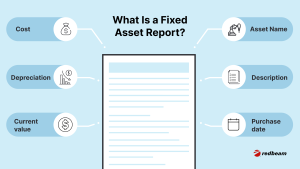How Asset Registers Support Fixed Asset Audits
Fixed asset audits are a critical component of financial management and compliance for businesses of all sizes. These audits ensure that an organization’s fixed assets are accurately recorded, accounted for, and valued. At the heart of a successful fixed asset audit lies a well-maintained asset register. In this article, we explore how asset registers support fixed asset audits, their benefits, and best practices to optimize the auditing process.
What Is a Fixed Asset Audit?

A fixed asset audit is a systematic review and verification of an organization’s fixed assets. Fixed assets typically include tangible items like machinery, vehicles, buildings, and equipment that have long-term value. The audit aims to confirm the existence, condition, and valuation of these assets and verify that they are correctly recorded in financial statements.
Purpose of Fixed Asset Audits
- Ensure accuracy in financial reporting and compliance with accounting standards
- Identify asset misappropriation or loss
- Verify depreciation calculations and asset valuations
- Support insurance and tax assessments
- Provide insights for asset lifecycle management and capital budgeting
What Is an Asset Register?
An asset register is a detailed record of all fixed assets owned by a company. It acts as a centralized database containing key information such as asset descriptions, purchase dates, acquisition costs, serial numbers, locations, depreciation schedules, and responsible users. Maintaining an accurate asset register is fundamental to effective fixed asset management and audits.
Types of Asset Registers
- Manual Registers: Often maintained in spreadsheets or paper form, these can be prone to errors and difficult to update in real-time.
- Digital Asset Registers: Cloud-based or software-driven systems that allow real-time updates, reporting, and integration with financial systems.
How Asset Registers Support Fixed Asset Audits
1. Providing Accurate and Complete Asset Records
A comprehensive asset register provides auditors with the foundational data needed to verify the existence and details of fixed assets. Accurate records reduce audit time and help identify discrepancies early in the process. This minimizes risks related to asset misstatements and financial inaccuracies.
2. Facilitating Physical Verification of Assets
During fixed asset audits, physical verification is essential. An asset register helps auditors locate assets by providing detailed information such as location, custodian, and identification numbers. This organized information allows auditors and internal teams to efficiently conduct site visits and confirm asset conditions.
3. Supporting Depreciation and Valuation Checks
Asset registers include depreciation schedules and acquisition costs, enabling auditors to verify that depreciation expenses are calculated correctly according to accounting standards such as IFRS or GAAP. This ensures that asset values on the balance sheet are accurate and compliant.
4. Improving Compliance and Risk Management
Maintaining an up-to-date asset register demonstrates internal controls and supports regulatory compliance. It reduces risks of asset misappropriation, theft, or loss by ensuring assets are tracked and managed consistently. Auditors view well-maintained registers as indicators of strong governance and control environments.
Benefits of Using a Digital Asset Register for Audits
Real-Time Updates and Accessibility
Digital asset registers enable real-time data entry and updates accessible by multiple stakeholders simultaneously. This ensures that auditors always work with the latest asset information, streamlining the audit process.
Automated Reporting and Analytics
Advanced asset management software can generate audit-ready reports such as asset listings, depreciation summaries, and maintenance logs automatically. Analytics tools help identify unusual patterns or anomalies, further supporting audit accuracy.
Integration with Financial Systems
Many digital asset registers integrate seamlessly with accounting and ERP systems, ensuring consistent data flow between asset management and financial reporting. This reduces manual reconciliation and errors during audits.
Best Practices for Maintaining an Asset Register to Support Audits
1. Conduct Regular Asset Inventories
Schedule periodic physical inventories to verify asset existence and condition. Regular audits ensure that the asset register reflects current information, preventing discrepancies during official fixed asset audits.
2. Standardize Data Entry Procedures
Create uniform data entry guidelines and templates to ensure consistency across departments. Include mandatory fields such as serial numbers, location, purchase details, and responsible persons.
3. Train Staff and Assign Accountability
Train employees on the importance of accurate asset recording and update protocols. Designate responsible individuals for asset management to maintain accountability and improve data quality.
4. Leverage Technology for Automation
Use barcode or RFID scanning to simplify asset identification and tracking. Automate depreciation calculations and reporting to reduce manual effort and human error.
Challenges in Fixed Asset Audits and How an Asset Register Helps
Data Inconsistency and Errors
Manual asset registers are prone to data inconsistencies and outdated records. A digital asset register helps maintain clean, standardized data, making audits smoother and more reliable.
Locating Assets Across Multiple Sites
Businesses with assets spread across different locations face difficulties in asset verification. An asset register with location tracking features provides a centralized overview, making physical audits more efficient.
Complex Depreciation Calculations
Depreciation methods can be complex, involving different asset classes and lifespans. Asset registers automate these calculations, ensuring accuracy and compliance with accounting standards.
Conclusion
Asset registers play a pivotal role in supporting fixed asset audits by providing accurate, organized, and up-to-date information about a company’s fixed assets. They streamline the audit process, reduce risks of financial misstatements, and enhance compliance with accounting and regulatory requirements.
By investing in a robust asset register—preferably a digital system—companies can ensure their fixed asset audits are efficient and reliable. Regular maintenance, staff training, and leveraging technology are key to maximizing the benefits of asset registers during audits.
Start Strengthening Your Fixed Asset Audits Today
Whether you are preparing for an upcoming audit or looking to improve your asset management practices, prioritizing an accurate asset register will provide peace of mind and greater control over your fixed assets.

